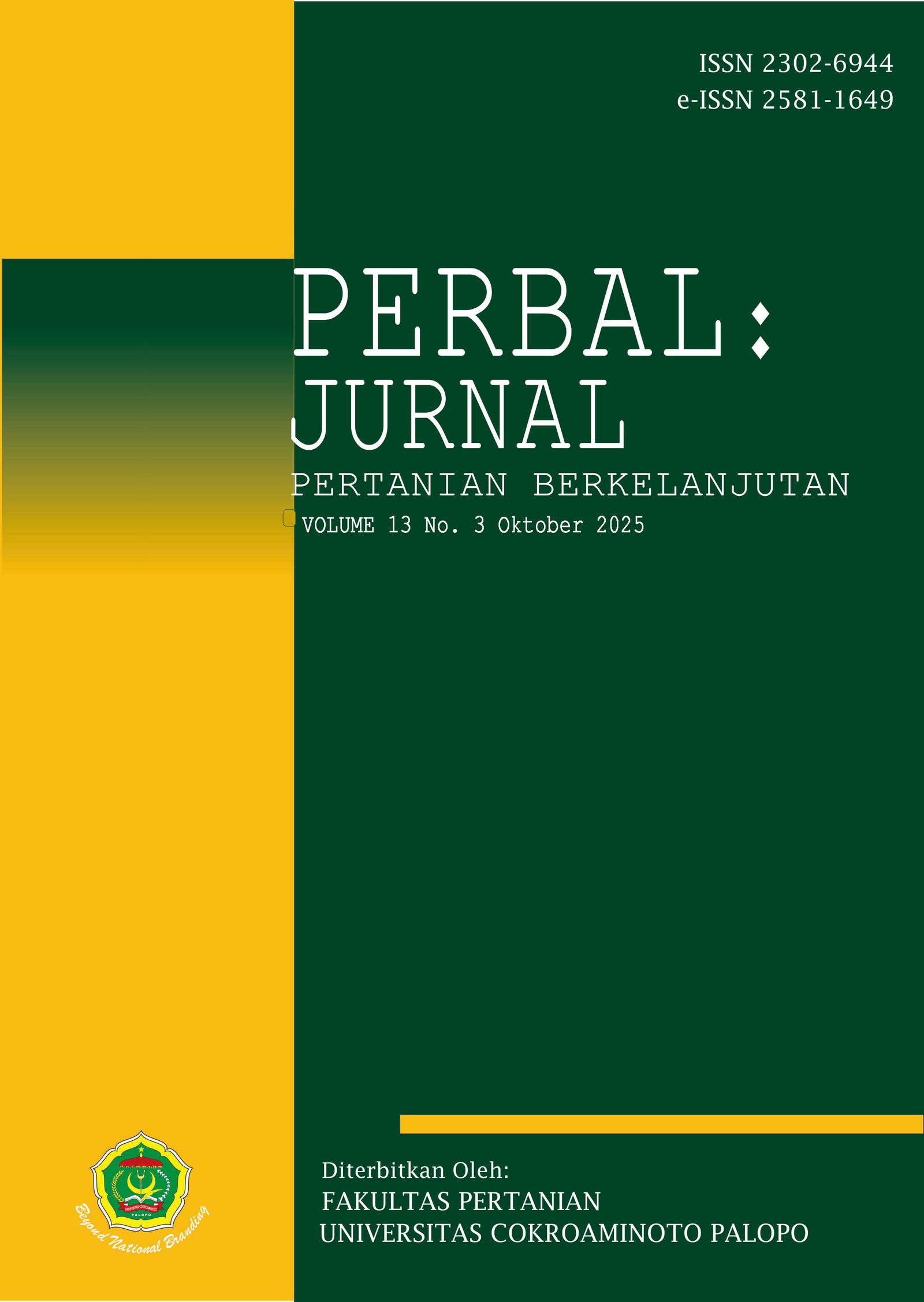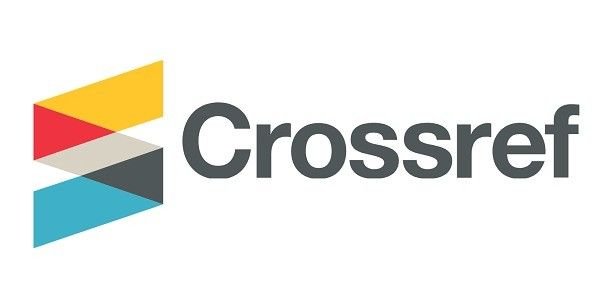Kualitas Biostimulan Berbahan Dasar Keong Mas dengan Penambahan Senyawa Aromatik Daun Jeruk Purut
Quality of Biostimulant Made from Snails with the Addition of Kaffir Lime Leaf Aromatic Compounds
DOI:
https://doi.org/10.30605/perbal.v13i3.6724Keywords:
Keong mas, biostimulan, daun jeruk purutAbstract
Keong mas dapat dimanfaat sebagai bahan perbanyakan mikoorganisme melalui fermentasi sebagai biostimulan. Biostimulan keong mas memiliki peran bagi tanaman untuk meningkatkan fotosintesis, system metabolisme dan ketahanan tanaman terhadap pengaruh abiotik. Hasil fermentasi biostimulan keong mas memberikan bau yang tidak sedap sehingga perlu dilakukannya inovasi perbaikan kualitas biostimulan dengan penambahan ekstrak daun jeruk purut. Penelitian ini dilakukan di kebun percobaan Laboratorium Lapang Politeknik Negeri Jember. Perlakuan yang diberikan, yaitu Formulasi 1 (F1): Ekstrak Keong Mas 1500ml + Aquadest 375ml + Em4 25ml + Gula merah 300ml tanpa daun jeruk purut; Formulasi 2 (F2): Ekstrak Keong Mas 1500ml + Aquadest 375ml + Em4 25ml + Gula merah 300ml+20gr daun jeruk purut; Formulasi 3 (F3): Ekstrak Keong Mas 1500ml + Aquadest 375ml + Em4 25ml + Gula merah 300ml+100gr daun jeruk purut; Formulasi 4 (F4): Ekstrak Keong Mas 1500ml + Aquadest 375ml + Em4 25ml + Gula merah 300ml+200gr daun jeruk purut. Variable pengamatan suhu, pH, warna dan aroma. Berdasarkan hasil pengamatan penambahan daun jeruk purut 200gram memberikan aroma wangi pada hasil fermentasi biostimulan keong mas. Perlakuan tanpa penambahan daun jeruk purut dan penambahan daun jeruk purut tidak memberikan pengaruh berbeda pada suhu, pH dan warna.
Golden snails can be used as a material for the propagation of microorganisms through fermentation as a biostimulant. Golden snail biostimulants have a role for plants to increase photosynthesis, metabolic systems, and plant resistance to abiotic influences. The results of fermenting golden snail biostimulants produce an unpleasant odor, so it is necessary to innovate and improve the quality of biostimulants by adding kaffir lime leaf extract. This research was conducted in the experimental garden of the Jember State Polytechnic Field Laboratory. The treatments given were Formulation 1 (F1): 1500ml Golden Snail Extract + 375ml Aquadest + 25ml EM4 + 300ml Brown sugar without kaffir lime leaves; Formulation 2 (F2): 1500ml Golden Snail Extract + 375ml Aquadest + 25ml EM4 + 300ml Brown sugar + 20gr of kaffir lime leaves; Formulation 3 (F3): 1500ml Golden Snail Extract + 375ml Aquadest + 25ml EM4 + 300ml Brown Sugar + 100gr Kaffir Lime Leaves; Formulation 4 (F4): 1500ml Golden Snail Extract + 375ml Aquadest + 25ml EM4 + 300ml Brown Sugar + 200gr Kaffir Lime Leaves. Observation variables are temperature, pH, color, and aroma. Based on the observation results, the addition of 200grams of kaffir lime leaves gives a fragrant aroma to the fermentation results of the golden snail biostimulant. Treatment without the addition of kaffir lime leaves and the addition of kaffir lime leaves did not give a different effect on temperature, pH, and color.
Downloads
References
Abidin, Z., Rusmini, R., Manullang, R.R., & Daryono, D. (2022). Kualitas mikroorganisme lokal dari keong mas dengan berbagai jumlah bahan yang berbeda. Agrosaintifika: Jurnal Ilmu-Ilmu Pertanian, 5(1), 31–38. https://doi.org/10.32764/agrosaintifika.v5i1.3189 DOI: https://doi.org/10.32764/agrosaintifika.v5i1.3189
Amien, A.C., Setiani, V., & Nindyapuspa, A. (2023). Pengaruh pengadukan terhadap perubahan suhu dalam pembuatan pupuk organik cair (POC) dari ampas tahu limbah ikan dan kotoran kambing. Journal Conference Proceeding on Waste Treatment Technology. Program Studi Pengolahan Limbah, Jurusan Teknik Permesinan Kapal, Politeknik Perkapalan Negeri, 6(01), 60–64. https://journal.ppns.ac.id/index.php/CPWTT/article/download/2751/1828/
Andriani, V. (2018). Aplikasi cangkang dan daging keong mas (Pomacea canaliculata L.) sebagai zat pengatur tumbuh organik terhadap pertumbuhan tanaman selada (Lactuca sativa L.). Stigma, 11(2), 9–16. https://jurnal.unipasby.ac.id/index.php/stigma/article/view/1659 DOI: https://doi.org/10.36456/stigma.vol11.no02.a1659
Du Jardin, P. (2015). Plant biostimulants: Definition, concept, main categories and regulation. Scientia Horticulturae, 196, 3–14. DOI: https://doi.org/10.1016/j.scienta.2015.09.021
Dwiputri, M.C., & Feroniasanti, Y.M.L. (2019). Effect of fermentation to total titrable acids, flavonoid and antioxidant activity of butterfly pea kombucha. The Internasional Seminar on Bioscience and Biological Education, 1–7. https://doi.org/10.1088/1742-6596/1241/1/012014 DOI: https://doi.org/10.1088/1742-6596/1241/1/012014
Fadilah, U., Wijaya, I.M.M., & Antara, N.S. (2018). Studi pengaruh pH awal media dan lama fermentasi pada proses produksi etanol dari hidrolisat tepung biji nangka dengan menggunakan Saccharomycess cerevisiae. Jurnal Rekayasa dan Manajemen Agroindustri, 6(2), 92–102. https://doi.org/10.24843/jrma.2018.v06.i02.p01 DOI: https://doi.org/10.24843/JRMA.2018.v06.i02.p01
Kesaulya, H., Baharuddin, Zakaria, B., & Syaiful, S.A. (2015). Isolation and physiological characterization of PGPR from potato plant rhizosphere in medium land of Buru Island. Procedia Food Science, 3, 190–199. https://doi.org/10.1016/j.profoo.2015.01.021 DOI: https://doi.org/10.1016/j.profoo.2015.01.021
Kusuma, M.E., & Kastalani. (2020). Efektifitas berbagai sumber air sebagai pelarut terhadap kualitas pupuk organik cair (POC) dari limbah RPH. Jurnal Ilmu Hewani Tropika, 9(2), 88–93. https://unkripjournal.com/index.php/JIHT/article/viewFile/174/170
Kusumadewi, M.A., Suyanto, A., & Suwerda, B. (2019). Kandungan nitrogen, phosphor, kalium, dan pH pupuk organik cair dari sampah buah pasar berdasarkan variasi waktu. Sanitasi: Jurnal Kesehatan Lingkungan, 11(2), 92–99. https://doi.org/10.29238/sanitasi.v11i2.945 DOI: https://doi.org/10.29238/sanitasi.v11i2.945
Mierziak, J., Kostyn, K., & Kulma, A. (2014). Flavonoids as important molecules of plant interactions with the environment. Molecules, 19(10), 16240–16265. https://doi.org/10.3390/molecules191016240 DOI: https://doi.org/10.3390/molecules191016240
Nendissa, D.M., & Nendissa, S.J. (2024). Uji aktivitas antibakteri ekstrak daun jeruk purut (Citrus hystrix) terhadap bakteri Escherichia coli dan Staphylococcus aureus. Jurnal Sains dan Teknologi Pangan, 9(3), 7492–7505. https://doi.org/10.33024/jikk.v8i3.4350 DOI: https://doi.org/10.33024/jikk.v8i3.4350
Panche, A.N., Diwan, A.D., & Chandra, S.R. (2016). Flavonoids: An overview. Journal of Nutritional Science, 5. https://doi.org/10.1017/jns.2016.41 DOI: https://doi.org/10.1017/jns.2016.41
Suharjono, S., Asmono, S.L., & Wardana, R. (2023). Pemanfaatan keong mas untuk pupuk organik cair di Kelompok Tani Podo Tentrem Kecamatan Wuluhan Jember. Journal of Community Development, 3(3), 272–278. DOI: https://doi.org/10.47134/comdev.v3i3.108
Visca, M.D., & Palla, S.Q. (2018). Golden apple snail, pomacea canaliculata meal as protein source for rabbitfish, siganus guttatus culture. AACL Bioflux, 533–542. https://www.researchgate.net/publication/324907781_Golden_apple_snail_Pomacea_canaliculata_meal_as_protein_source_for_rabbitfish_Siganus_guttatus_culture
Wahyuni, D., & Nafi’ah, S. (2022). Uji efektivitas repellent ekstrak daun jeruk purut (Citrus hystrix D.C) terhadap Nyamuk Aedes aegypti. Jurnal Pharma Bhakta, 20–29. https://jurnalpharmabhakta.iik.ac.id/index.php/jpb/article/view/13
Yunilas, Y., Siregar, A.Z., Mirwhandhono, E., Purba, A., Fati, N., & Malvin, T. (2022). Potensi dan karakteristik larutan mikroorganisme lokal (MOL) berbasis limbah sayur sebagai bioaktivator dalam fermentasi. Journal of Livestock and Animal Health, 5(2), 53–59. https://doi.org/10.32530/jlah.v5i2.540 DOI: https://doi.org/10.32530/jlah.v5i2.540
Downloads
Published
Issue
Section
License
Copyright (c) 2025 Nisa Budi Arifiana, Sepdian Luri Asmono, Rahmawati Rahmawati, Mochamad Syarief, Dessy Putri Andini

This work is licensed under a Creative Commons Attribution 4.0 International License.
In submitting the manuscript to the journal, the authors certify that:
- They are authorized by their co-authors to enter into these arrangements.
- The work described has not been formally published before, except in the form of an abstract or as part of a published lecture, review, thesis, or overlay journal.
- That it is not under consideration for publication elsewhere,
- That its publication has been approved by all the author(s) and by the responsible authorities – tacitly or explicitly – of the institutes where the work has been carried out.
- They secure the right to reproduce any material that has already been published or copyrighted elsewhere.
- They agree to the following license and copyright agreement.
License and Copyright Agreement
Authors who publish with Onoma Journal: Education, Languages??, and Literature agree to the following terms:
- Authors retain copyright and grant the journal right of first publication with the work simultaneously licensed under Creative Commons Attribution License (CC BY 4.0) that allows others to share the work with an acknowledgment of the work's authorship and initial publication in this journal.
- Authors are able to enter into separate, additional contractual arrangements for the non-exclusive distribution of the journal's published version of the work (e.g., post it to an institutional repository or publish it in a book), with an acknowledgment of its initial publication in this journal.
- Authors are permitted and encouraged to post their work online (e.g., in institutional repositories or on their website) prior to and during the submission process, as it can lead to productive exchanges, as well as earlier and greater citation of published work.














